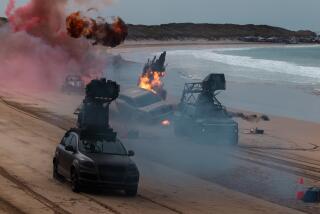He set the scene
In his half-century career in film, Oscar-winning production designer Terence Marsh performed some amazing transformations. In director David Lean’s 1965 “Doctor Zhivago,” for which he won his first Academy Award, Marsh and the other designers turned Spain into Russia during the communist revolution.
For Carol Reed’s Oscar best picture winner, “Oliver!” (1968), which earned Marsh his second Oscar, he captured the bleakness and poverty of 19th century London in the musical adaptation of Charles Dickens’ “Oliver Twist.” And in Frank Darabont’s 1999 prison drama “The Green Mile,” Marsh’s imagining of death row and its decrepit electric chair had a palpable sense of horror.
Sometimes Marsh worked on big-budget extravaganzas. Other times he had to improvise as he did for the 1975 comedy “The Adventure of Sherlock Holmes’ Smarter Younger Brother,” which marked the directorial debut of Gene Wilder. Using his wits and some old-fashioned tricks of the trade, Marsh was able to re-create a Victorian London on the Shepperton Studios set that would have impressed Arthur Conan Doyle.
“We had one scene in a hansom cab with Gene and another hansom cab draws up alongside and they are trying to murder Gene,” Marsh related. “He climbs on the roof of the cab and they have a fight on top of the cabs with whips. Thank God, we had a production designer’s two favorite things going for us -- night and fog. I told Gene I can do the building on either side very economically with period posters and we do the side shot with doubles on top of the roof of the cab. We got a marvelous-looking film.”
Regardless of the scale or the type of film, Marsh was always passionate about his job. Now 80, he reflected on his journey that took him from art college in England to working with some of the top directors in Hollywood.
“It’s a crazy business,” said the easygoing Marsh, relaxing recently on the enclosed porch of the 1920s Spanish-style home in Pacific Palisades that he shares with his wife, agent Sandra Marsh. The vintage home -- John Barrymore’s old mansion is next door -- offers a bird’s-eye view of the Pacific Ocean.
He began in films working for famed producer J. Arthur Rank. During his six years with Rank, he learned the craft from such noted designers as Carmen Dillon, Alex Vetchinsky and Maurice Carter. He worked as a draftsman on Rank films including 1957’s “The Prince and the Showgirl” with Laurence Oliver and Marilyn Monroe and the 1958 Titanic drama “A Night to Remember.”
After leaving Rank, he landed a job as assistant art director for production designer John Box on David Lean’s 1962 masterpiece “Lawrence of Arabia,” which took two years and was shot in various locations including Spain and England.
“ ‘Lawrence’ is what got me going,” Marsh recalled. “It got me to be friends with John and then John made me his art director on his very next film, ‘Of Human Bondage.’”
The legendary director Lean, Marsh noted, was “always polite. He wasn’t a shouter or a screamer, but he was rather cold. He was a technician rather than a warm person. He didn’t feel comfortable with actors.”
“Doctor Zhivago,” like “Lawrence,” took two years to film. “We were looking for locations and we settled on Spain,” he said, noting that the country had the infrastructure to supply hundreds of extras and horses. The interiors were shot at a film studio, but the production crew had trouble finding an exterior location where they could construct two distinct neighborhoods for the upper and lower classes.
So Marsh drove around the countryside to find a suitable place to build these neighborhoods. He came across a large parcel of land that was vacant save for paved roads. “A developer wanted to build a group of houses on the land,” said Marsh. “He had put the roads in, but hadn’t yet got around to building the homes. We did a deal.”
Over the years, he was production designer on such hits as 1992’s erotic thriller “Basic Instinct,” the action-adventures “The Hunt for Red October” and its sequels, “Patriot Games” and “Clear and Present Danger” (1990 and 1994) and Darabont’s 1994 prison drama “The Shawshank Redemption.”
Marsh retired after completing the 2001 blockbuster comedy “Rush Hour 2,” with Chris Tucker and Jackie Chan, which was directed by Brett Ratner.
“Brett was really young then,” he said of the experience. “It was a completely different world than Lean and Carol Reed. It was joining a lot of jolly school boys having fun. They wrote the script as we went along, which was not good for the art department.”
It wasn’t the casualness of “Rush Hour” that prompted him to get out of the business. “I liked Brett,” he said. “But I was 70 and I thought it was time to retire. I miss the camaraderie of the art department, but I don’t miss the wrangles over the budget.”
--
More to Read
Only good movies
Get the Indie Focus newsletter, Mark Olsen's weekly guide to the world of cinema.
You may occasionally receive promotional content from the Los Angeles Times.







